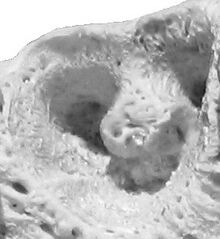Biology:Ursus dolinensis
| Ursus dolinensis Gran Dolina bear | |
|---|---|
| Scientific classification | |
| Domain: | Eukaryota |
| Kingdom: | Animalia |
| Phylum: | Chordata |
| Class: | Mammalia |
| Order: | Carnivora |
| Family: | Ursidae |
| Genus: | Ursus |
| Species: | †U. dolinensis
|
| Binomial name | |
| †Ursus dolinensis Garcia and Arsuaga, 2001[1]
| |
Ursus dolinensis (the Gran Dolina bear) is an extinct mammalian carnivore species of the Ursidae family. Its fossilized remains were unearthed from the lowest layers of the stratigraphic sequence at the archaeological and paleontological site of Gran Dolina (also Trinchera Dolina, a section of the Trinchera Ferrocaril, lit. Railroad trenches), that is a part of the Atapuerca Mountains complex in the Burgos province, northern Spain .[2] The species was described by Nuria Garcia and Juan Luis Arsuaga in a 2001 publication.[1] Skeletal fossils, mainly cranial fragments were recovered from the sediment units TD 3 and in particular TD 4 (TD = Trinchera Dolina). Presence in these layers suggests a chronology in between 900,000 and 780,000 years ago, which falls into the Calabrian stage of the early Pleistocene.
Morphology
The species has been described as the most primitive of all cave bears, and smaller than a black bear. It has a slender body comparable to brown bears (Ursus arctos) and noticeably gracile features of the cranial and mandibular bones, that to some extent resemble those of Ursus arctos and Ursus etruscus. Yet its overall morphological characteristics suggest a kinship with the line of the speleoid bears.[3] Finally Garcia and Arsuaga have concluded that Ursus dolinensis "is the ancestor of Ursus savini and to be very close to the common ancestor of Ursus arctos".[1]
The type specimen of the Gran Dolina bear is a 255 mm (10.04 in) long left mandible fragment with the acronym Ata96-TDW4-E9-1, that retains the canine, a premolar 4, a molar 2 and the alveoli of the premolars P1, P2 and P3. Several paratype fossils include an incomplete right mandible, a right lower molar, another lower molar, two jaw fragments, one phalanx bone of the foot and a metatarsal bone.[4] The discovery of a complete Ursus dolinensis skull during the 2012 excavation campaign and its analysis has according to the campaign's co-directors Eudald Carbonell, J.M. Bermúdez and J.L. Arsuaga helped to better determine the species' phylogenetic position.[5]
Nuria Garcia described more of the species' specific morphology in a comparison with the Untermaßfeld bear at the 18th International Senckenberg Conference in Weimar in 2004. She confirms the primitive brown bear-like features and highlights detailed dental traits shared by the two species, such as a "slender horizontal ramus with straight vertical profile; all teeth sides converge towards the midline". The fourth lower premolars are massive and elliptical shaped with a prominent protoconid.[lower-alpha 1] The first lower molars are slender, the second lower molars are rectangular shaped and without medial constrictions. The fourth upper premolars are triangular shaped with simple high pointed cusps. The first upper molars are quadrangular to rectangular-shaped without central constriction and finally, the second upper molars are large without torsion.[7]
Notes
- Footnotes
References
- ↑ 1.0 1.1 1.2 Nuria Garcı́a, Juan Luis Arsuaga (2001-06-15). "Ursus dolinensis: a new species of Early Pleistocene ursid from Trinchera Dolina, Atapuerca (Spain)". Comptes Rendus de l'Académie des Sciences, Série IIA 332 (11): 717–725. doi:10.1016/S1251-8050(01)01588-9. Bibcode: 2001CRASE.332..717G.
- ↑ "The Pleistocene site of Gran Dolina, Sierra de Atapuerca". Ftp.grupoedelweiss.com. http://ftp.grupoedelweiss.com/pdf/the%20pelistocene%20site%20of%20Gran%20Dolina.pdf.
- ↑ "comparisons with Ursus dolinensis from Atapuerca and other early and Middle Pleistocene sites.". Senckenberg.de. http://www.senckenberg.de/fis/doc/abstracts/30_Garcia.pdf.
- ↑ "Revision of the early Middle pleistocene bears". Geology.cz. http://www.geology.cz/bulletin/fulltext/1354_Wagner.pdf.
- ↑ "SOMETHING MORE THAN BONES: A SKULL OF URSUS DOLINENSIS AT ATAPUERCA". Solohuesos-isabelcaceres.blogspot.com. 2 August 2012. http://solohuesos-isabelcaceres.blogspot.com/2012/08/un-craneo-de-ursus-dolinensis-en.html.
- ↑ "Protoconid". Medical-dictionary.thefreedictionary.com. http://medical-dictionary.thefreedictionary.com/protoconid.
- ↑ N. Garcia. "New results on the remains of Ursidae from Untermaßfeld: Comparison with Ursus dolinensis from Atapuerca and other Early and Middle Pleistocene sites". Senckenberg.de. http://www.senckenberg.de/fis/doc/abstracts/30_Garcia.pdf.
External links
- García, Nuria and Arsuaga, Juan Luis (2001). "Ursus dolinensis: a new species of early Pleistocene Ursid from Trinchera Dolina, Atapuerca (Spain) = Ursus dolinensis: une nouvelle espèce d'ursidé inférieur du Pléistocène Trinchera Dolina, Atapuerca (Spain)" . Comptes rendus de l'Académie des sciences. Série 2. Sciences de la terre et des planètes 332 (11). 1251–8050, 717-725 .
Wikidata ☰ Q6158080 entry
 |


